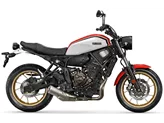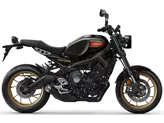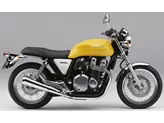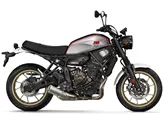Yamaha XSR700 2017 vs. Yamaha XSR900 2018

Yamaha XSR700 2017

Yamaha XSR900 2018
Overview - Yamaha XSR700 2017 vs Yamaha XSR900 2018
The Yamaha XSR700 2017 and the Yamaha XSR900 2018 are both naked bikes from Yamaha, offering different features and specifications.
Starting with the engine and drive train, the XSR700 2017 is equipped with a 2-cylinder in-line engine that produces 75 horsepower and 68 Nm of torque. On the other hand, the XSR900 2018 comes with a 3-cylinder in-line engine that delivers a more powerful 115 horsepower and 87.5 Nm of torque. This makes the XSR900 2018 more suitable for riders looking for a sportier and more rev-happy engine.
In terms of cooling, both models have liquid cooling systems to ensure optimal engine performance. The XSR700 2017 has a displacement of 689ccm, while the XSR900 2018 has a larger displacement of 847ccm, providing more power and torque.
When it comes to suspension, the XSR700 2017 features a telescopic fork in the front and a swing arm with a monoshock in the rear. The XSR900 2018 also has a swing arm with a monoshock in the rear, but it is equipped with an upside-down telescopic fork in the front. This gives the XSR900 2018 an advantage in terms of suspension technology, providing better handling and stability.

Yamaha XSR700 2017
In terms of chassis, the XSR700 2017 has a steel frame, while the XSR900 2018 features an aluminum frame. The aluminum frame of the XSR900 2018 offers a lighter and stiffer construction, contributing to better overall performance and handling.
Both models have double disk brakes in the front, but the XSR900 2018 has larger diameter disks (298mm) compared to the XSR700 2017 (282mm). This results in improved braking performance and better control for the XSR900 2018.
In terms of dimensions and weights, the XSR900 2018 has a slightly longer wheelbase (1440mm) compared to the XSR700 2017 (1405mm). The seat height is the same for both models at 815mm. The XSR900 2018 is slightly heavier with a kerb weight of 191kg, while the XSR700 2017 weighs 186kg (both with ABS). Both models have a fuel tank capacity of 14 liters.
Moving on to the strengths of each model, the XSR700 2017 is praised for its wonderful engine, solid workmanship, cool retro look, and a large range of original accessories. It is also appreciated for its great automatic gearshift, sporty and tight chassis, and being easy to drive, making it enjoyable for riders of all ages.

Yamaha XSR900 2018
On the other hand, the XSR900 2018 is commended for its extremely sporty and rev-happy engine, excellent brakes, and riding experience at a naked bike level. It offers a pleasant seating position and high-quality workmanship, along with a good price-performance ratio.
However, both models have their weaknesses. The XSR700 2017 is criticized for the readability of the display, the license plate holder being a matter of taste, and the lack of consistency in some design details. It also suffers from poor wind protection when driving at high speeds.
The XSR900 2018, on the other hand, is said to have an almost too direct response from the engine and a retro style that is not thought through to the last detail.
In conclusion, the Yamaha XSR700 2017 and the Yamaha XSR900 2018 are both impressive naked bikes from Yamaha, each with its own set of strengths and weaknesses. The XSR700 2017 offers a wonderful engine and a cool retro look, while the XSR900 2018 provides a more powerful engine and excellent brakes. Ultimately, the choice between the two models depends on the rider's preferences and priorities.
Technical Specifications Yamaha XSR700 2017 compared to Yamaha XSR900 2018
Pros and Cons in comparison
Pros and Cons in comparison
Yamaha XSR700 2017

La XSR est pour moi la moto parfaite pour le quotidien. Elle est un régal pour les yeux, elle est incroyablement puissante, tout en étant légère et agile. La position d'assise permet de longues sorties, car les bagages peuvent être portés sans problème sur le dos. La XSR elle-même ne sait pas vraiment ce qu'elle veut être maintenant. Mais je trouve trouve le mélange qui en résulte plutôt intéressant. Pour ceux qui ne veulent pas (ou ne peuvent pas) avoir plusieurs motos dans leur garage, la XSR est un très bon choix. est bien servie. Elle apporte tout ce que l'on attend d'une moto. Dans un hôtel, on parlerait d'une offre tout compris. Elle est parfaite pour pour les trajets quotidiens au bureau, pour les excursions du week-end et les petits tours dans le sud. Même avec un passager, la moto se déplace très facilement. Comme d'habitude chez Yamaha, la moto donne une impression de solidité. Ici, tout fonctionne. L'échappement est agréablement silencieux, mais à partir de 5000 tours, il produit un son très agréable et puissant. L'arrière est une question de goût. Personnellement, je modifierais l'arrière et j'enlèverais les éléments en plastique. En outre, je trouve que les rétroviseurs standard sont un peu grands. Ici, l'aspect rétro n'a pas été totalement respecté. Mais cela peut être modifié grâce aux de nombreux accessoires, très rapidement et facilement. Le tableau de bord est en principe bien lisible. Cependant, de nombreuses informations sont sont logées dans l'espace. C'est là que le design et la fonctionnalité se confondent un peu. Résumé en une phrase : Le vélo parfait pour tous les défis.
Yamaha XSR900 2018

La Yamaha XSR900 est une illusion d'optique classique - avec son phare rond, son réservoir anguleux et son feu arrière rapporté, elle passe clairement pour une moto rétro. Mais ce n'est pas un hasard si ses performances rappellent celles de la puissante moto tout terrain de classe moyenne Yamaha MT-09, car celle-ci constitue la base extrêmement sportive de la XSR900. Le moteur est donc une merveille et les freins sont très puissants. En ce qui concerne le châssis, les techniciens n'exagèrent heureusement pas, la XSR900 offre suffisamment de confort et la position d'assise droite est plus confortable que ne le laisserait supposer le moteur puissant. Dans la catégorie des motos rétro, la XSR900 est néanmoins l'un des modèles les plus sportifs.
Price Comparison Avarage Market Price Yamaha XSR700 vs Yamaha XSR900
There are a few key differences between a Yamaha XSR700 2017 and a Yamaha XSR900 2018. In terms of price, the actual average price of a Yamaha XSR900 2018 is about 17% higher. A Yamaha XSR700 2017 experiences a loss of 110 USD in one year and 780 USD in two years of ownership. This is offset by a loss of 180 USD and 120 USD for a Yamaha XSR900 2018. Compared to Yamaha XSR900 2018 there are more Yamaha XSR700 2017 bikes available on the 1000PS.de Marketplace, specifically 7 compared to 4. It takes less time to sell a Yamaha XSR700 with 91 days compared to 123 days for a Yamaha XSR900. Since model year 2015 1000PS.de editors have written 26 reviews for the Yamaha XSR700 and 30 reviews for the Yamaha XSR900 since model year 2016. The first review for the Yamaha XSR700 was published on 7/22/2015 and now has more than 13,700 views. This compares to more than 17,600 views for the first review on Yamaha XSR900 published on 11/25/2015.




















